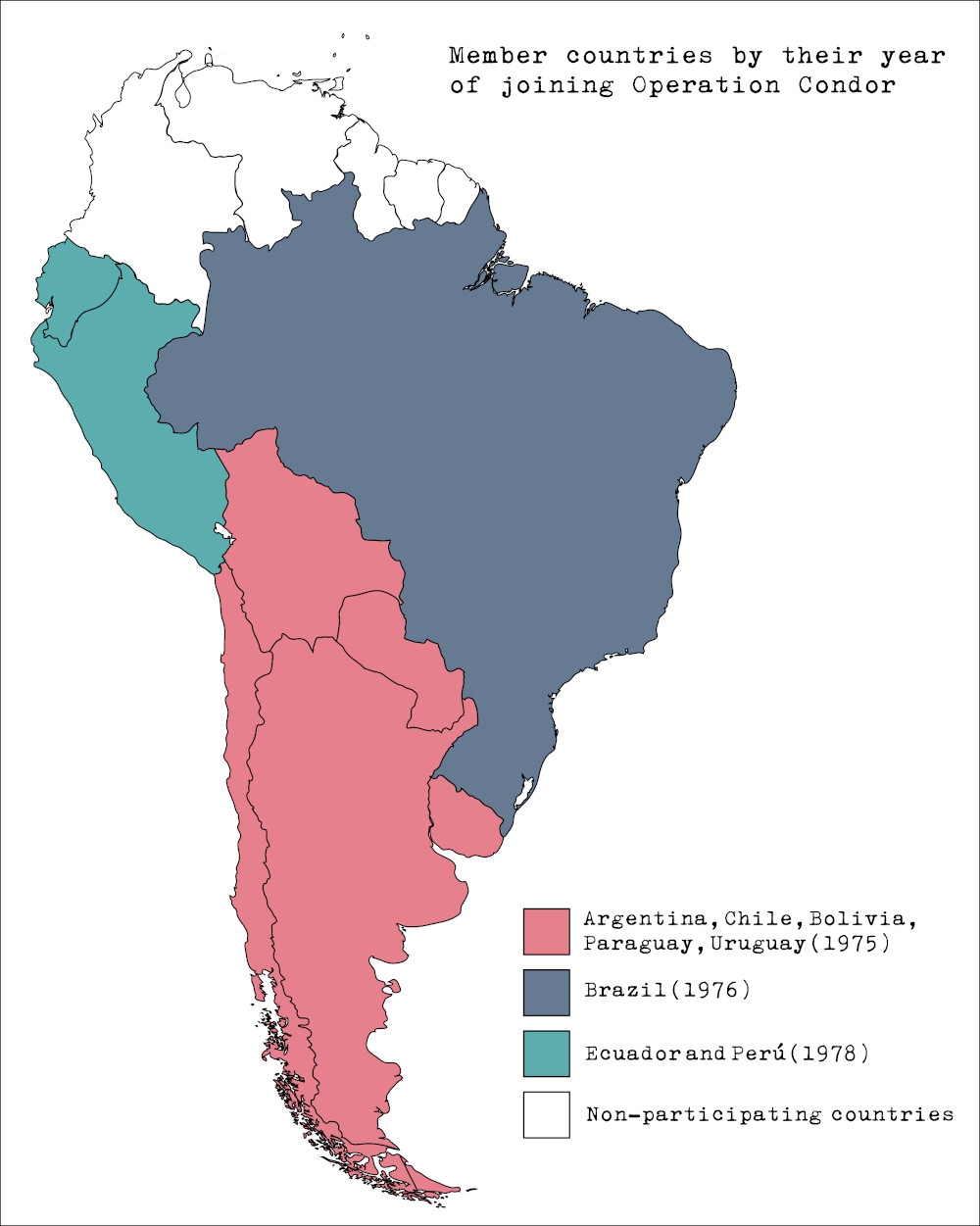Authoritarian regimes inspired by the National Security Doctrine expanded across the length and breadth of South America under the geopolitical context of the Cold War. Authoritarian regimes swept across the region, beginning with Paraguay in 1954, followed by Brazil in 1964, and then came another wave of military coups that struck Bolivia in 1971, Uruguay and Chile in 1973, and, finally, Argentina in 1976.
The regimes brutally and systematically repressed all forms of opposition, targeting not only members of leftist armed groups, but also political leaders, teachers, students, journalists, union leaders, and political and socialist activists. Though there were some differences between the dictatorships, they collectively perpetrated thousands of crimes against humanity such as extrajudicial executions, illegal captures, forced disappearances, torture and inhumane treatment, baby stealing, and sexual violence.
Since the beginning of the 1970s, the political repression which had been developing within each country acquired an added regional dimension of terror through the so-called Operation Condor. Towards the end of November 1975, representatives of the military regimes of Argentina, Bolivia, Chile, Paraguay and Uruguay gathered in the Chilean capital of Santiago, where they established the so-called “Condor System” or Operation Condor. According to the Minutes of the Conclusion of the First Interamerican Meeting on National Intelligence, the Uruguayan delegation proposed to name the system after the Andean Condor bird to honour the host country, Chile. The motion was approved unanimously by the representatives.
 The transnational network of Operation Condor allowed dictatorships to specifically target exiles who had fled their home countries and continued to denounce the dictatorships in power from abroad. In some cases, Condor also persecuted relatives who were looking for their disappeared loved ones and/or refugees who were no longer politically active. By 1978, Operation Condor encompassed eight out of the 13 South American countries (see map) and, in practice, it had established a borderless area of terror and impunity in South America, affecting hundreds of victims. A declassified FBI document from September 1976 affirms that “members of “Operation Condor” showing the most enthusiasm to date have been Argentina, Uruguay and Chile.”
The transnational network of Operation Condor allowed dictatorships to specifically target exiles who had fled their home countries and continued to denounce the dictatorships in power from abroad. In some cases, Condor also persecuted relatives who were looking for their disappeared loved ones and/or refugees who were no longer politically active. By 1978, Operation Condor encompassed eight out of the 13 South American countries (see map) and, in practice, it had established a borderless area of terror and impunity in South America, affecting hundreds of victims. A declassified FBI document from September 1976 affirms that “members of “Operation Condor” showing the most enthusiasm to date have been Argentina, Uruguay and Chile.”
Condor reproduced the same range of human rights violations as those being carried out by the regimes within their own borders, but with an added ingredient: the transnational nature of the crimes. There were three branches of transnational operations:
- The exchange of information between two or more countries, including the home country of the victim/s and the host country;
- Joint operations carried out by international task forces comprised of agents of the country where the victim was found and their counterparts from the victim’s country of origin (sometimes backed by agents of other interested countries);
- The illegal transfer of individuals from the country of their detention back to their home country.
Operation Condor drew on and surpassed the previous informal and ad hoc forms of bilateral cooperation, alongside the pre-existing exchange of information and joint operations between the region’s armed forces and intelligence services that had been developing since the late 1960s. The Condor System rested on three main pillars:
- A database situated in Santiago de Chile, which centralised all the intelligence information about subversion in the region;
- Condortel, a secret and encrypted communications channel enabling member countries to exchange information about prisons and sought individuals, to trace the movement of militants across borders, to send orders to operations teams, and to exchange intelligence information throughout South America. Condortel followed a simple alphabetical order for the original five Condor states: #1 was Argentina, #2 was Bolivia, #3 was Chile, #4 was Paraguay, #5 was Uruguay, while Brazil maintained observer status;
- Condoreje, the office for coordination and advanced commands, oversaw operational activities. The office was probably situated in a SIDE building at 2457 Billinghurst Street, in the Recoleta neighbourhood of Buenos Aires. Officers stationed there processed incoming intelligence, including information and requests transmitted by Condortel, into orders for raids and kidnappings, and operational teams were dispatched to execute the orders.
Teseo was a distinct initiative, but still reflected Condor’s collaborative philosophy. Composed of Argentine, Uruguay, and Chilean agents, Teseo was established to conduct special operations in Europe to primarily target members members of the Junta de Coordinación Revolucionaria (Revolutionary Coordinating Junta, JCR) in France, as well as political figures, such as the Uruguayans Hugo Cores and Wilson Ferreira, and the US congressional representative, Edward Koch. Assassinations were planned for approximately 20 intended victims, but all missions were aborted after the CIA presumably alerted the French intelligence services.
